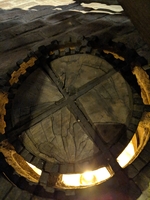Overview
- Brief Narrative
- Metal sewer manhole cover housing from the Miła Street neighborhood of the Warsaw ghetto in Poland. Before World War II, Warsaw was home to the second largest Jewish community in the world and a major center of Jewish life and culture, as well as the capital and largest city in Poland. Following the German invasion of Poland on September 1, 1939, the city was occupied by German soldiers and a ghetto was quickly established on October 12, 1940. The population of the 1.3 square mile ghetto swelled to 400,000 as Jews from surrounding areas were forced to move in. The food allotments issued in the ghetto were not enough to feed the population, necessitating the creation of a smuggling network that used, among other avenues, the sewers to bring in food and medicine. In the summer of 1942, approximately 265,000 Jews were taken from the ghetto to Treblinka killing center where they were murdered, and another 35,000 Jews were killed inside the ghetto. In January 1943, Schutzstaffel (SS) and police units returned to take the Jews to forced labor camps. However the remaining inhabitants were able to resist and the Germans were forced to pull out. In April, 1943, the SS and police force returned to liquidate the ghetto. Many prisoners resisted in what came to be known as the Warsaw Ghetto Uprising, while others used the sewers to hide and escape. By May 16, the Germans had crushed the uprising and left the ghetto in ruins. When the city was liberated in 1945, only 11,500 Jews were left in the city.
- Date
-
use:
1940 October 12-1943 May 16
- Geography
-
use:
Warsaw (Poland)
- Credit Line
- United States Holocaust Memorial Museum Collection, Gift of the Warsaw City Authority
Physical Details
- Classification
-
Tools and Equipment
- Category
-
Equipment
- Object Type
-
Manhole covers (lcsh)
- Genre/Form
- Manhole covers.
- Physical Description
- Black, metal sewer housing with a square top that extends outward from the base. The housing has several raised square and rectangular ridges on the surface and a large hole in the center. The interior of the hole has dimpled sides and a raised lip at the bottom to hold the sewer cover (b.). There are small patches of surface rust on the top and slight corrosion on a few of the raised ridges.
- Dimensions
- overall: Height: 13.000 inches (33.02 cm) | Width: 24.125 inches (61.278 cm) | Depth: 24.125 inches (61.278 cm)
- Materials
- a : metal
Rights & Restrictions
- Conditions on Access
- No restrictions on access
- Conditions on Use
- No restrictions on use
Keywords & Subjects
Administrative Notes
- Legal Status
- Permanent Collection
- Provenance
- The manhole housing was donated to the United States Holocaust Memorial Museum in 1990 by the Warsaw City Authority.
- Record last modified:
- 2023-06-14 07:08:01
- This page:
- https://collections.ushmm.org/search/catalog/irn3511
Download & Licensing
In-Person Research
- By Appointment
- Request 21 Days in Advance of Visit
- Plan a Research Visit
- Request to See This Object
Contact Us
Also in Warsaw City Authority collection
The collection consists of a manhole cover and housing from the center of Warsaw, Poland, in the area that served as a ghetto from October 1940 to May 1943.
Date: 1940 October 12-1943 May 16

Manhole cover from the Miła Street neighborhood in the former Warsaw ghetto
Object
Metal sewer manhole cover from the Miła Street neighborhood of the Warsaw ghetto in Poland. Before World War II, Warsaw was home to the second largest Jewish community in the world and a major center of Jewish life and culture, as well as the capital and largest city in Poland. Following the German invasion of Poland on September 1, 1939, the city was occupied by German soldiers and a ghetto was quickly established on October 12, 1940. The population of the 1.3 square mile ghetto swelled to 400,000 as Jews from surrounding areas were forced to move in. The food allotments issued in the ghetto were not enough to feed the population, necessitating the creation of a smuggling network that used, among other avenues, the sewers to bring in food and medicine. In the summer of 1942, approximately 265,000 Jews were taken from the ghetto to Treblinka killing center where they were murdered, and another 35,000 Jews were killed inside the ghetto. In January 1943, Schutzstaffel (SS) and police units returned to take the Jews to forced labor camps. However the remaining inhabitants were able to resist and the Germans were forced to pull out. In April, 1943, the SS and police force returned to liquidate the ghetto. Many prisoners resisted in what came to be known as the Warsaw Ghetto Uprising, while others used the sewers to hide and escape. By May 16, the Germans had crushed the uprising and left the ghetto in ruins. When the city was liberated in 1945, only 11,500 Jews were left in the city.



